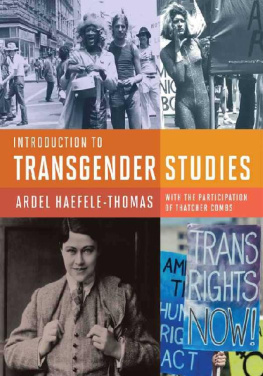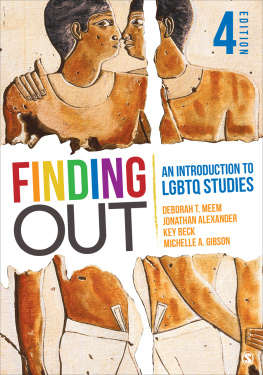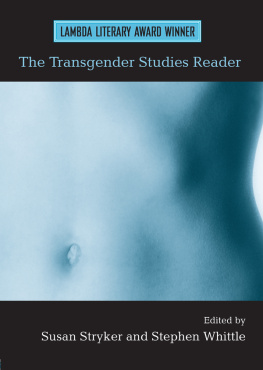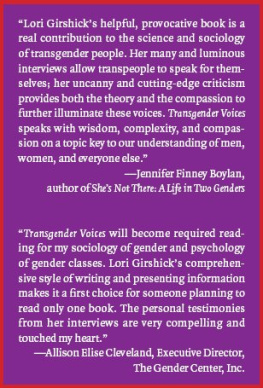Copyright 2019 by Harrington Park Press, LLC
All rights reserved. No part of this publication may be reproduced, distributed or transmitted in any form or by any means, including photocopying, recording, or other electronic or mechanical methods, without the prior written permission of the publisher, except in the case of brief quotations embodied in critical reviews and certain other noncommercial uses permitted by copyright law. For permission requests, write to the publisher, addressed Attention: Permissions Coordinator, at the address below.
Harrington Park Press
Box 331
9 East 8th Street
New York, NY 10003
E-ISBN 978-1-939-59428-0
http://harringtonparkpress.com
Library of Congress Cataloging-in-Publication Data
Names: Haefele-Thomas, Ardel, author.
Title: Introduction to transgender studies / Ardel Haefele-Thomas ; with the participation of Thatcher Combs ; illustrations by Cameron Rains.
Description: New York : Harrington Park Press, [2019] | Includes bibliographical references and index.
Identifiers: LCCN 2018035468 (print) | LCCN 2018037860 (ebook) | ISBN 9781939594280 (ebook) | ISBN 9781939594273 (pbk. : alk. paper)
Subjects: LCSH: Gender nonconformityStudy and teaching. | Transsexualism. | Transgender people. | Transsexuals.
Classification: LCC HQ77.9 (ebook) | LCC HQ77.9 .T496 2019 (print) | DDC 306.76/8-dc23
LC record available at https://lccn.loc.gov/2018035468
In Memory of
James Miranda Barry
Frances Thompson
Louis Graydon Sullivan
Marsha P. Johnson
Sylvia Rivera
Leslie Feinberg
In Honor of
Miss Major Griffin-Gracy
TGI Justice
Dedicated to
Lisa Haefele
Jalen Haefele-Thomas
Austin Mantele
CONTENTS
by Susan Stryker
by Jo Clifford
DETAILED CONTENTS
by Susan Stryker
by Jo Clifford
Introduction to Transgender Studies is the first introductory textbook to the field of transgender (trans) studies. While numerous outstanding books are available in the rapidly growing field of trans studies, they often focus on theory, with an intended audience of graduate students; or they are autobiographical or biographical and thus look at only one person; or they explore only one topic, such as health care, legal systems, history, or coming out as trans to family and friends. In contrast, Introduction to Transgender Studies is the first full-length textbook to introduce trans studies as a rich field of study that encompasses and connects global contexts, intersecting identities, historic and contemporary issues, literature, history, politics, art, and culture. Each of its twelve chapters includes key concepts, original artwork by Cameron Rains, never-before-published essays by trans people and allies from around the world, an extensive list of film and television of interest, numerous topics for student discussion, in-class and out-of-class activities, and ideas for writing and research that range from informal reports to formal research projects.
Intended Audience
The intended audience for Introduction to Transgender Studies is undergraduates in courses ranging from introductory gender studies courses and introductory LGBTQ+ studies courses to more specific classes focusing on the expanding field of transgender studies. This text can also be used in graduate courses focusing on pedagogical practices in gender studies, feminist studies, LGBTQ+ studies, and transgender studies.
The Need for This Book
The seeds for this book came from my own teaching in the writing program at Stanford University, where I taught feminist rhetoric and queer rhetoric, as well as my teaching at City College of San Francisco in the LGBT Studies Department and Berkeley City College in the Womens Studies Department. In all these settings, undergraduates were eager to learn about contemporary transgender issues as well as the rich global history of gender diversity through the ages. Textbooks published for courses in LGBTQ+ studies often have minimal focus on transgender issues and experiences. More broadly, in womens studies, feminist studies, and gender studies, most textbooks highlight womens issues and womens lived experiences; more to the point, they tend to focus on cisgender women and rarely consider the experiences of trans women. Even the feminist and gender studies texts that now include masculinity studies often do not consider trans studies or the expansion of gender beyond the binary. When trans issues are introduced, they are often discussed within the context of a person transitioning and crossing the gender binary from one pole to another. While Introduction to Transgender Studies honors trans people who identify along a male/female binary, it is also mindful of ancient cultures that honored gender diversity with third-, fourth-, and fifth-gender identities as well as contemporary nonbinary, agender, and gender-expansive identities.
A Welcoming, Student-Centered Approach
Introduction to Transgender Studies takes a student-centered approach. In my women and gender studies, feminist philosophy, LGBT studies, and transgender studies classes, I have often found that students experience a good deal of anxiety, trepidation, and confusion when studying issues pertaining to sex and gender, gender identity, gender expression, and sexual orientation. Even students who identify within the gay, lesbian, bisexual, transgender, queer, intersex (or differences of sex development)+ community often find it difficult to distinguish among sexual orientation, gender identity, and gender expression. I wrote this book to create a safe space for the full spectrum of undergraduate students, ranging from those who have never thought about gender issues to students who identify as transgender, trans, nonbinary, agender, and/or gender expansive.
In short, the language and the artwork in this book are meant to be welcoming. They invite the reader and the instructor to find ways to discuss gender issues and gender identities and issues in a safe and comfortable way. I have tried to make the text welcoming to newcomers who may not have thought about trans issues, as well as to gender-expansive students who have. Often, these students sit side by side in the same classroom. The text promotes dialogue, communication, and mutual respect.
Class-Tested
The first two chapters of this book were piloted with great success among undergraduates in a wide range of institutions of higher learning, including community colleges, public state universities, and private colleges and universities. At the University of Colorado in the United States and at the University of Exeter in the United Kingdom, these chapters were successfully piloted in graduate courses, with the goal of students considering the material in light of their own pedagogical practices in teaching.
















